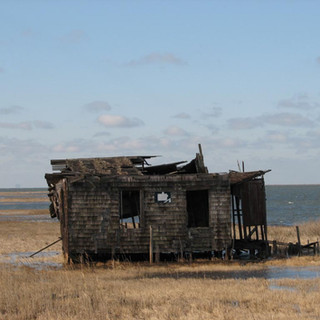The Shack
- bay-mag
- May 1, 2018
- 3 min read
Long Beach Island is known for its multimillion-dollar and architecturally significant homes, however, sitting in a marsh along Barnegat Bay, one small, rustic, weather-beaten cabin captured the hearts and imagination of multiple generations of Long Beach Island residents and vacationers -- The Shack. Located off to the right on Eastbound Route 72 as you crossed Bonnet Island, the Shack called out, “Welcome to LBI,” for over 80 years.

Photo by Ann Coen
From Gunning Club To Symbol of Survival
The Shack was an ordinary hunting cabin built sometime in the 1920s. Known as the Happy Day Club, it accommodated duck hunters and provided hunting supplies such as decoys, sodding, and sneak boxes (a unique boat developed in Barnegat Bay to navigate shallow water). Gun Clubs were common in the early 20th century and the Shack was actually one of three similar structures in the area, all of them on the north side of the Route 72 Causeway. In 1957 a new causeway was under construction and the Happy Day Club was moved to the opposite side of the roadway where it became an unofficial “Welcome to LBI” landmark. The Shack stood alone in the marsh alongside the Barnegat Bay and became a muse for countless artists who captured the Shack’s mystery and historic allure in paintings, photographs, and sculptures. Over time the Shack became one of the most talked about and artistically captured sites associated with LBI.
As the decades passed the Shack became less of a sporting club and, in the 1960s and 1970s, more of a place for parties. It was eventually abandoned and the Shack slowly started to fall apart. What was once a two-story cabin with quarter moon openings carved into its shutters eventually became what some referred to as “a pile of sticks.” After strong storms and harsh winters, the conversation of residents and vacationers turned to wondering if the Shack would still be there. The little hunting cabin became a symbol of survival.
Photo by Tanke Hood | Photo by Peg O’Hara | Photo by Trina Garrett
What To Do With The Shack?
Recognizing its frailty, the public began to consider options for the future of their beloved Shack. Ideas included a Viking funeral in which the Shack would be burned down in an honored tradition, building an acrylic enclosure to “freeze” it in time, and even building a replica on LBI to be turned into a Shack art museum.
Spurred by his personal history and love of the Shack (and its ties to the history of early baymen), local LBI resident James Yuhas started a “Save the Shack” movement. He took it upon himself to brace its deteriorating walls and adorn it with a large American Flag. His goal was to get people interested in restoring the Shack in any way possible. At the same time, the land surrounding the Shack had been purchased for the installation of billboards. The new owner was willing to work on a restoration project, however aside from the lengthy process of working through the Department of Environmental Protection and the Army Corps of Engineers, there was a question of legal ownership of the property. Working together with Stafford Township and the Ocean County Cultural and Heritage Commission a clear title dating back to the 1600s was obtained in 2011. That same year a fundraising effort to raise money and supplies for a restoration project was launched with the creation of savetheshack.com, and a video documentary was produced by Sean Gallagher, whose grandfather was an artist who painted the shack in the 1980s. Through great efforts, major hurdles had been resolved, but time was still running out.
The End
The Shack had survived the historic storms of the 1930s and 1940s, and later the great Nor’easter of 1962. Just as the reality of restoring the Shack was within sight, Superstorm Sandy struck. Weakened by years of exposure to the harsh elements of the coastal New Jersey, the Shack fell victim; a short report from the Harvey Cedars Police on October 30, 2012, reported, “the shack was gone as of 7 A.M.” Its demise was not witnessed and all that remained were four supportive pilings.
The Future
Today most people still remember the Shack and talk fondly about how long it stood and when it was lost, but what about the newcomers who have never actually seen the Shack – what will become their welcome sign? Maybe a replica shack will be built to remind travelers of the history of the Bay, or maybe the countless paintings and photos will be enough to tell the story of the Shack. One thing is for sure, the Shack was a survivor and an inspiration to many during its 80 years of existence, and its legacy will carry on in the future as well.














